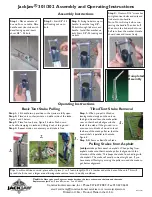
Unable to increase Chlorine
Produc
ti
on
Cell is plugged with debris, cold water,
low salt level
Check cell and clean, check salt
level, check water temperature.
Problem with power to Control Center
Check to make sure On/OFF Switch
is on.
Make sure pump is on.
Check Circuit Breaker (Part C on
Illustra
ti
on, page 13) on bo
tt
om of
Control Center; if tripped, press
rubber cover to reset
No AC power to Control Center
Verify
ti
me clock is providing 220
VAC to Control Center when ac
ti
ve
(TO BE DONE BY CERTIFIED POOL
PROFESSIONAL, OR ELECTRICAN)
System Status light solid
System is opera
ti
ng normally
No solu
ti
on, everything is
fi
ne.
Enjoy your pool!
Status light is
fl
ashing or service
light is on while opera
ti
ng on
low output percentage.
Low salt level, dirty cell, damaged cell
blade coa
ti
ngs.
Set the output to “Boost” and then
hold down the upward arrow
bu
tt
on un
ti
l the polarity lights begin
to
fl
ash back and forth. Check to see
if status light has stopped
fl
ashing
or the service light has turned o
ff
.
The system will not turn on.
Incorrect or no voltage coming from the
power source.
Have an experienced pool
professional or an electrician
con
fi
rm that the voltage is existent
and correct.
Circuit breaker may be tripped
Check the circuit breaker located on
the control center box and reset the
breaker is it has been tripped.
Circuit boards may be damaged.
Call manufacturer to troubleshoot
the system with a technician.
The cell housing is leaking from
the cap (bo
tt
om of cell cap or
through the cord hole)
O-ring may be improperly seated.
Con
fi
rm that O-ring has not been
lubricated. Clean the o-ring slot of
any dirt or debris. Fully seat the o-
ring in into the slot before inser
ti
ng
the cell back into the housing.
Cell cap may be cross threaded.
Unscrew cap and con
fi
rm that the
cap screws onto the housing
without resistance.
Water is leaking from the cell
plug.
Water is traveling through a crack in the
cell base and up the cell cord.
Call manufacturer and troubleshoot
the system with a technician.
The
ti
tanium “legs” that hold up
the cell blades have broken
apart from the blades.
The legs have been eaten away due to
corrosive water.
Call manufacturer to troubleshoot
the system with a technician.
The weld that held the “legs” and blades
together has failed.
Call manufacturer to troubleshoot
the system with a technician.
Troubleshooting
continued
20






































